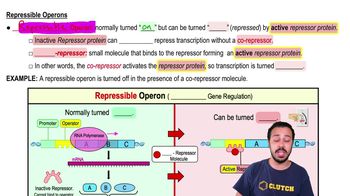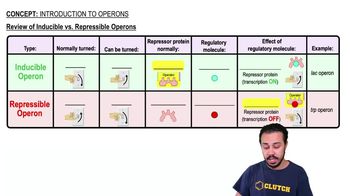Table of contents
- 1. Introduction to Biology2h 42m
- 2. Chemistry3h 40m
- 3. Water1h 26m
- 4. Biomolecules2h 23m
- 5. Cell Components2h 26m
- 6. The Membrane2h 31m
- 7. Energy and Metabolism2h 0m
- 8. Respiration2h 40m
- 9. Photosynthesis2h 49m
- 10. Cell Signaling59m
- 11. Cell Division2h 47m
- 12. Meiosis2h 0m
- 13. Mendelian Genetics4h 44m
- Introduction to Mendel's Experiments7m
- Genotype vs. Phenotype17m
- Punnett Squares13m
- Mendel's Experiments26m
- Mendel's Laws18m
- Monohybrid Crosses19m
- Test Crosses14m
- Dihybrid Crosses20m
- Punnett Square Probability26m
- Incomplete Dominance vs. Codominance20m
- Epistasis7m
- Non-Mendelian Genetics12m
- Pedigrees6m
- Autosomal Inheritance21m
- Sex-Linked Inheritance43m
- X-Inactivation9m
- 14. DNA Synthesis2h 27m
- 15. Gene Expression3h 20m
- 16. Regulation of Expression3h 31m
- Introduction to Regulation of Gene Expression13m
- Prokaryotic Gene Regulation via Operons27m
- The Lac Operon21m
- Glucose's Impact on Lac Operon25m
- The Trp Operon20m
- Review of the Lac Operon & Trp Operon11m
- Introduction to Eukaryotic Gene Regulation9m
- Eukaryotic Chromatin Modifications16m
- Eukaryotic Transcriptional Control22m
- Eukaryotic Post-Transcriptional Regulation28m
- Eukaryotic Post-Translational Regulation13m
- 17. Viruses37m
- 18. Biotechnology2h 58m
- 19. Genomics17m
- 20. Development1h 5m
- 21. Evolution3h 1m
- 22. Evolution of Populations3h 52m
- 23. Speciation1h 37m
- 24. History of Life on Earth2h 6m
- 25. Phylogeny2h 31m
- 26. Prokaryotes4h 59m
- 27. Protists1h 12m
- 28. Plants1h 22m
- 29. Fungi36m
- 30. Overview of Animals34m
- 31. Invertebrates1h 2m
- 32. Vertebrates50m
- 33. Plant Anatomy1h 3m
- 34. Vascular Plant Transport1h 2m
- 35. Soil37m
- 36. Plant Reproduction47m
- 37. Plant Sensation and Response1h 9m
- 38. Animal Form and Function1h 19m
- 39. Digestive System1h 10m
- 40. Circulatory System1h 57m
- 41. Immune System1h 12m
- 42. Osmoregulation and Excretion50m
- 43. Endocrine System1h 4m
- 44. Animal Reproduction1h 2m
- 45. Nervous System1h 55m
- 46. Sensory Systems46m
- 47. Muscle Systems23m
- 48. Ecology3h 11m
- Introduction to Ecology20m
- Biogeography14m
- Earth's Climate Patterns50m
- Introduction to Terrestrial Biomes10m
- Terrestrial Biomes: Near Equator13m
- Terrestrial Biomes: Temperate Regions10m
- Terrestrial Biomes: Northern Regions15m
- Introduction to Aquatic Biomes27m
- Freshwater Aquatic Biomes14m
- Marine Aquatic Biomes13m
- 49. Animal Behavior28m
- 50. Population Ecology3h 41m
- Introduction to Population Ecology28m
- Population Sampling Methods23m
- Life History12m
- Population Demography17m
- Factors Limiting Population Growth14m
- Introduction to Population Growth Models22m
- Linear Population Growth6m
- Exponential Population Growth29m
- Logistic Population Growth32m
- r/K Selection10m
- The Human Population22m
- 51. Community Ecology2h 46m
- Introduction to Community Ecology2m
- Introduction to Community Interactions9m
- Community Interactions: Competition (-/-)38m
- Community Interactions: Exploitation (+/-)23m
- Community Interactions: Mutualism (+/+) & Commensalism (+/0)9m
- Community Structure35m
- Community Dynamics26m
- Geographic Impact on Communities21m
- 52. Ecosystems2h 36m
- 53. Conservation Biology24m
16. Regulation of Expression
Prokaryotic Gene Regulation via Operons
Problem 6`
Textbook Question
What would occur if the repressor of an inducible operon were mutated so it could not bind the operator?
a. Irreversible binding of the repressor to the promoter
b. Reduced transcription of the operon's genes
c. Buildup of a substrate for the pathway controlled by the operon
d. Continuous transcription of the operon's genes
 Verified step by step guidance
Verified step by step guidance1
Understand the role of a repressor in an inducible operon: In an inducible operon, the repressor protein binds to the operator region to prevent transcription. When an inducer molecule is present, it binds to the repressor, causing it to change shape and release from the operator, allowing transcription to proceed.
Consider the effect of a mutation that prevents the repressor from binding to the operator: If the repressor cannot bind to the operator, it cannot block RNA polymerase from transcribing the genes in the operon.
Analyze the consequences of continuous transcription: Without the repressor binding to the operator, RNA polymerase can continuously transcribe the operon's genes, leading to the production of mRNA and, subsequently, the proteins encoded by the operon.
Evaluate the options given in the problem: Option a (irreversible binding of the repressor to the promoter) is incorrect because the mutation prevents binding. Option b (reduced transcription) is incorrect because transcription would increase. Option c (buildup of a substrate) is not directly related to the mutation's effect on transcription. Option d (continuous transcription) aligns with the expected outcome of the mutation.
Conclude that the correct answer is option d: The mutation results in continuous transcription of the operon's genes, as the repressor cannot bind to the operator to inhibit transcription.
 Verified video answer for a similar problem:
Verified video answer for a similar problem:This video solution was recommended by our tutors as helpful for the problem above
Video duration:
2mPlay a video:
Was this helpful?
Key Concepts
Here are the essential concepts you must grasp in order to answer the question correctly.
Inducible Operon
An inducible operon is a segment of DNA that includes genes regulated by a repressor protein. In its default state, the repressor binds to the operator, preventing transcription. When an inducer molecule is present, it binds to the repressor, causing it to release from the operator, allowing transcription to proceed. This system is typically used to regulate genes involved in catabolic pathways.
Recommended video:
Guided course

Inducible Operons
Repressor Protein
A repressor protein is a regulatory protein that binds to the operator region of an operon, inhibiting the transcription of downstream genes. In inducible operons, the repressor is inactivated by an inducer, allowing gene expression. If a mutation prevents the repressor from binding to the operator, the genes may be transcribed continuously, as the repressor cannot block RNA polymerase.
Recommended video:
Guided course

Proteins
Operator Region
The operator is a segment of DNA within an operon where the repressor protein binds to regulate gene expression. It acts as a switch that can turn gene transcription on or off. In inducible operons, the presence of an inducer prevents the repressor from binding to the operator, thus allowing transcription. A mutation that prevents repressor binding would result in continuous gene transcription.
Recommended video:
Guided course

Terrestrial Biomes: Northern Regions Example 1

 0:53m
0:53mWatch next
Master Prokaryotic Gene Regulation via Operons with a bite sized video explanation from Jason
Start learningRelated Videos
Related Practice










